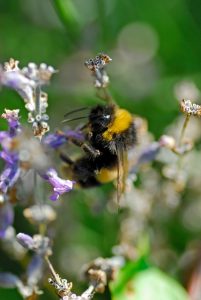
With spring in the air it’s a wonderful time to be outdoors. A few days of sunshine reminds us that the hills and vales, the meadows, woodlands, parks and especially our gardens are precious habitats for wildlife. Whether it’s the birds singing in the hedgerow, the bumblebees nesting in the compost heap or the frogs and toads spawning in the pond, wild places are vital for nature to feed, breed and shelter.
Gardeners understand about the cycles of nature, they observe the seasons in their plots, sowing seeds with the turn of spring and nurturing the seedlings in the protected environs of glasshouses, cold frames, cloches and tunnels until the icy fingers of Jack Frost are a distant memory. Gardeners feed the soil first and the plants second. They harness the power of nature in their composting systems feeding the worms and microbes as they break down the natural material into a rich, crumbly soil improver.
Gardeners revere water and appreciate the precious commodity as they tend their crops and gardens.
Dangerous liaisons
But all is not perfect in our garden nature reserves. Not all garden owners are gardeners, understanding the fragile relationship with nature. Many are garden owners or members of the generation rent, where the garden is an extra space to temporarily host summer activities, position pots and containers, or just a space that needs continual care and attention. They may look for the short cuts, the fast results with little understanding of the importance of their outdoor room.
Danger tools
As wildlife refuges our plots are a precious space and yet danger lurks in every corner. As the weather warms and the breeding season starts in earnest, the garden bursts into growth like a butterfly hatching from its chrysalis, flapping it’s silken wings until it gains the strength and energy to fly. The undergrowth thickens, the weeds start to take over and the lawn turns from a neat green carpet into a virtual cornfield complete with wildflowers. But take great care before you start to tackle your garden overgrowth.

Before you brandish your garden trimmer (otherwise known as a strimmer) check carefully in the undergrowth. Nesting hedgehogs are a common victim of these powerful machines. One whip of a nylon line rotating at hundreds of revolutions per minute can rip apart sheltering creatures. I know because I have seen first hand the damage to a rescue hedgehog, found in next-door’s garden. A few minutes ruffling through the undergrowth would have saved this hog’s life; instead it was subjected to a hideous injury and abject pain until it could be put out of its misery. A total waste of a precious life. This little hog was a rescue hog that had been nurtured for months before its release back into the wild. It had survived the winter and emerged from hibernation, a difficult time in a hog’s life, only to meet an untimely death at the hands of a piece of gardening equipment. A cruel and pointless death.
Killer gardens
Our gardens harbour all sorts of dangers for wildlife. Power tools are capable of horrific injuries to any living creature and even children and pets; employ with great care.
Pesticides are toxins that are designed to kill. It’s imperative to understand that they have a wide target and can affect a huge swath of living entities. Think of the bigger picture. Insecticides don’t just kill insects. Remember that wherever they are used, they remove the insects from the food chain, creating a dearth of food for insectivorous creatures such as birds, hedgehogs, frogs and toads that need these bugs to survive. It’s their staple diet. And what of the residues that lurk in the soil and leach into the water table, streams and brooks? Let alone the concentrates stored in our sheds and garages. Save yourself the bother, the cost and the potential risks and deal with pests manually. Hand weed the paths and borders, wash off the bugs from your plants and if you must, use traps and barriers with care and understanding instead of poisons.
Supporting wildlife
We can all do a bit more to support and protect our wildlife.
- Take care around the compost heap. Before you spear the pile with a fork to turn it over, spare a thought for the creatures that nest within its warmth and protection. Remove the top layer by hand and ensure there are no nesting hogs or other precious creatures underneath.
- Create a boggy area near the pond and ensure there is a shallow end to allow wildlife to drink safely and escape if they fall in.
- NEVER use antifreeze in water features. Wildlife, pets and creatures that pass through your garden will drink from your fountain and DIE.
- Feed the birds and provide fresh, clean water at all times.
- Create a bee drinker filled with pebbles, marbles or sea beans where insects can drink safely without drowning.
- Leave some of your garden to grow wild. A patch of unkempt wilderness is vital for wildlife. The wildflowers, the dandelions, daisies and even the nettles are vital food for pollinators. The flowers providing pollen and nectar, the nettles food for hungry caterpillars.
- Think about your use of nets and netting. Little creatures can become trapped quickly in the mesh and in their panic get more and more entangled. Keep it above ground level and check regularly.
- Clear up litter. Empty cans and food packs are a magnet for hungry creatures. Elastic bands and wire can cause hideous injuries, collect them up and dispose of it safely.
- Learn more about making your garden a safe haven for wildlife here: http://www.littlehistories.co.uk/willowshedgehogrescue-helping-hogs.html


